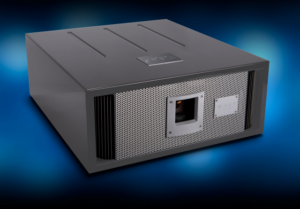Wolf Cinema has modified several existing D-ILA (LCoS) projectors to ready its lineup for the new year. Four models have been updated and two are ‘new’.
The SDC-8, SDC-10, SDC-12 and SDC-15 projectors are the updated units. Wolf Cinema has changed them to support upcoming DCI-4k (4096 x 2160) consumer video content, with the addition of HDMI 2.0 ports. Using these interfaces, says Wolf, the projectors can show high-resolution content at 60fps with 4:4:4 sub-sampling (see comments, below).
In addition to a new HDMI port, the projectors are HDR compatible, with custom factory gamut and gamma calibration and VariScope aspect ratio memories. Wolf also claims that peak white brightness has been raised by up to 30%, to 1,700 (SDC-8), 1,800 (SDC-10) and 1,900 (SDC-12/SDC-15) lumens.
Two ‘new’ flagship platforms have also been created, although they still use the SDC-12 and SDC-15 projectors. Wolf has combined these products with a custom outboard ProScaler Mark IV video processor. The processor adds an expanded CMS calibration suite and advanced noise reduction algorithms.
All six projectors feature a fourth-generation V4K temporal mapping technology core. Prices start at $8,000. Wolf Cinema will show the projectors at CES 2016.
Analyst Comment
When HDMI 2.0 was first announced (Display Monitor Vol 20 No 35), the HDMI Forum was criticised because many of the new features were optional: companies were (and still are) able to describe an interface as ‘HDMI 2.0’ if it supported UltraHD at 60fps (‘4k60’), even if it used 4:2:0 subsampling.
When HDMI 2.0 was first released, there were no chips or hardware supporting the full 18Gbps data rate (HDMI 2.0 Has Several Flavors so Be Careful). This meant that 4k60 and 4:4:4 (17.82Gbps) was not feasible. However, the 10.2Gbps rate of HDMI 1.4 could support content at 4:2:0 (8.9Gbps). Many manufacturers adopted this path.
Chips now exist that can support the 18Gbps data rate, and so we are seeing an increasing number of products that play 4k60 at 4:4:4. These are limited to 8-bit colour, however; 10-bit and higher still requires 4:2:0. (TA)

